Fix: BlueScreen Recovery Error 0xc0000017 on Windows
The 0xc0000017 error code appears after an unsuccessful clean install or upgrades that ends in a BSOD (Blue Screen of Death). It’s accompanied by the error message ‘There isn’t enough memory to create a ramdisk device.’ This error code sands for STATUS_NO_MEMORY and it’s signalling that there are not enough virtual memory or swap files quotas for the specified locations.

What’s causing the 0xc0000017 BSOD on Windows?
- 3rd party Antivirus Interference – If you’re encountering the issue while trying to update to Windows 10 from an older windows version, the first culprit you should look at is your Antivirus suite. It’s possible that it determines that the operation is not safe so it stops the communications between the upgrading tool and the external Microsoft server. In this case, you can resolve the issue by stopping or uninstalling the 3rd party security suite while the upgrading process is active.
- Insufficient RAM – If you have a lot of USB-connected devices but not a lot of RAM, it’s possible that this issue occurs due to the fact that your hardware is not capable of allocating enough memory to complete the upgrading process. In this case, one fix that will allow you to complete the process without upgrading your hardware is to disconnect all non-essential USB devices.
- Outdated motherboard driver – As it turns out, another potential culprit that will raise this issue is an incompatible motherboard driver that’s not capable of accommodating Windows 10. If this scenario is applicable, you can resolve the issue by updating your motherboard drivers to the latest versions.
- Bad memory blocks – As it’s been confirmed by Microsoft, this problem can also occur due to a series of bad memory blocks that will stop your OS from creating the Windows PE environment necessary for the upgrade. In this case, you can resolve the issue by cleaning the bad memory entries from an elevated CMD prompt.
- Hybrid graphics are enabled – If you’re using a Zbook HP model, chances are you’re encountering this issue due to the fact that hybrid graphics are enabled in your BIOS settings. To fix this problem, simply access your BIOS settings and disable Hybrid graphics or switch them to Discrete Graphics.
- Different 3rd party interference – As it turns out, there are several different 3rd party applications that might cause this error code including utility apps. To ensure that no 3rd party service or process is causing this problem, achieve a clean boot and retry the process once again.
Method 1: Stopping the AV suite (if applicable)
If you’re facing this issue when attempting to upgrade your Windows version to Windows 10, you should start this troubleshooting quest by eliminating the possibility of 3rd party interference. As it turns out, it’s possible that an overprotective Antivirus suite is stopping the upgrading operation in its tracks due to a false positive.
Comodo, Avast, McAffee are most commonly reported for causing this behaviour, but there might be others. If this scenario is applicable and you’re actually using a 3rd party suite that might cause this interference, you should test to see if the operation is successful if you’re doing it while the Antivirus suite is disabled or uninstalled.
You can start things slowly by disabling real-time protection and retrying the upgrading process. If the 0xc0000017 BSOD no longer appears, you can conclude that your AV was causing the problem. With most security suites, you can do it directly from the taskbar menu.

However, if you’re using a 3rd party security suite that includes a firewall, disabling the real-time protection will not be enough since the same security suite will remain firmly in place. If this scenario is applicable, the only viable fix is to uninstall the Antivirus + firewall completely and ensure that there are no leftover files that might still cause the same behaviour.
Here’s a quick guide on how to uninstall the problematic 3rd party suite and remove any remnant files that might still prevent the upgrade from taking place:
- Press Windows key + R to open up a Run dialogue box. Next, type ‘appwiz.cpl’ and press Enter to open the Programs and Features menu.

Typing in “appwiz.cpl” in the Run prompt - Once you’re inside the Applications and Features menu, scroll down through the list of installed applications and locate the 3rd party security suite that you wish to uninstall. When you see it, right-click on it and choose Uninstall from the newly appeared context menu.
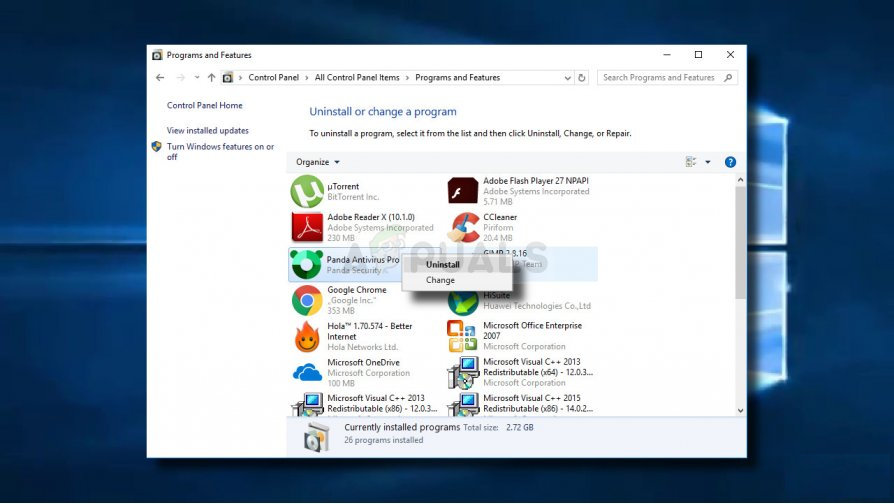
Uninstalling your antivirus - Follow the on-screen instructions to complete the installation, then restart your computer to save the changes.
- Open this article (here) and follow the instructions there to remove any remnant files associated with the AV suite that you just uninstalled.
If the same issue is still occurring or this method wasn’t applicable to your particular scenario, move down to the next potential fix below.
Method 2: Disconnect all external devices
The 0x0000017 is associated with ‘bad memory’, but in reality, the problem most likely occurs because the memory allocation is too high, so the system doesn’t have enough left to complete the upgrading/installation process.
This can be resolved easily by adding additional RAM, equipping your computer with the hardware necessary to complete the process.
But if you have no plans of upgrading your PC specifications, you can probably easy the memory allocation by unplugging every unnecessary USB device. Several affected users have confirmed that this method was successful for them.
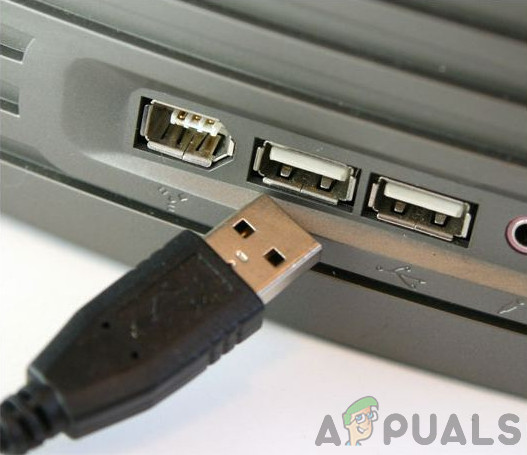
If the device is not running, there’s no need to allow it to reserve memory. With this in mind, unplug every non-essential USB device and repeat the process that was causing the 0xc0000017 – There isn’t enough memory to create a ramdisk device.
If this scenario is not applicable or you’re looking for a different approach, move down to the next potential fix below.
Method 3: Updating motherboard drivers
As it turns out, this problem can also be caused by a severely outdated motherboard driver that is not compatible to accommodate Windows 10. Several users that we’re encountering the 0xc0000017 error during the upgrade to Windows 10 have reported that the process was finally successful after they updated their motherboard driver to the latest version.
Windows Update is notoriously known for failing to update motherboard drivers, so chances are you will need to do it manually.
Here’s a quick guide on how to update your motherboard manually:
- Visit the official website of your motherboard manufacturer and download the latest drivers available. If you don’t know your motherboard model, you can download & use Speccy to find it out.

Downloading the motherboard driver Note: Ensure that you download your motherboard drivers from the official channels. Stay away from 3rd party download websites unless you absolutely need to go through them.
- Open the installation executable and follow the on-screen prompts to install the driver that was previously failing to install.
- Once the installation is complete, restart your computer and see if the issue is resolved at the next system startup.
If the same 0xc0000017 error code is still occurring or you already have the latest driver version, move down to the next potential fix below.
Method 4: Cleaning the bad memory entries
Microsoft has already investigated this issue and confirmed that this particular issue can also occur in instances where the OS tries to create the RAM disk for the Windows PE environment during the boot process. If during this operation, bad memory blocks are discovered in the BCD store, you can expect to see 0xc0000017 error code as a result.
If this scenario is applicable, you can resolve the issue fairly easily by using a series of CMD commands capable of checking and cleaning bad memory entries in the BCD store. Here’s a quick guide on how to do this:
- Press Windows key + R to open up a Run dialogue box. Next, type ‘cmd’ inside the text box and press Ctrl + Shift + Enter to open up an elevated Command prompt. When you get at the User Account Control (UAC) prompt, click on Yes to approve the admin request.

Running Command Prompt - Once you’re inside the elevated Command Prompt, type the following command and press Enter to list all bad memory entries:
bcdedit /enum {badmemory} - In case the investigation above has shown you that the BCD store is indeed containing bad memory blocks that are preventing the creation of the ramdisk, the next step is to clean those entries. To do this, type the following command and press Enter:
bcdedit /deletevalue {badmemory} badmemorylist - After the process is successful, restart your computer and see if the issue is resolved at the next system startup.
If you’re still encountering the 0xc0000017 error code even after you followed the instructions above, move down to the next potential fix below.
Method 5: Disabling Hybrid Graphics from BIOS
As it turns out, this issue can also occur due to a GPU feature present on integrated AMD GPU cards called Hybrid graphics. Several affected users have confirmed that after going into their BIOS settings and disabling Hybrid Graphics from the Device Configuration menu, they upgrading / clean install process completed successfully with no additional problems.
This method is typically reported to be successful with ZBook models manufactured by HP.
Here’s a quick guide on disabling Hybrid Graphics from BIOS settings:
- Power your computer on (or initiate a restart if it’s already on). As soon as you see the initial loading screen, repeatedly press the Setup (BIOS key).
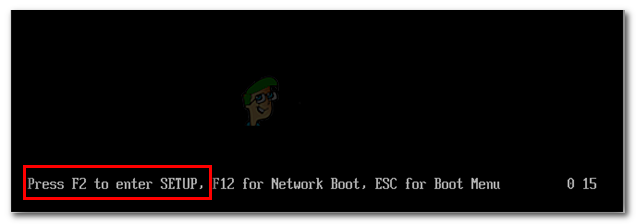
Press the BIOS key during startup procedure Note: With most motherboards, the setup key will be displayed on the screen. But in case you don’t see it, you can search online for specific instructions on entering your BIOS settings according to your motherboard model.
- Once you manage to get inside your BIOS settings, use the navigation menu to access the Advanced menu. Once inside, select the Device Configuration menu and ensure that Graphics Device is set to Discrete Graphics instead of Hybrid Graphics.

Disabling Hybrid graphics Note: If you find an option that allows you to set Hybrid Graphics to Disabled, do it.
- Make sure to save the chance by choosing Save Changes and Exit BIOS.
- Once the next startup sequence is complete, see if the same issue is still occurring.
If the same problem is still occurring, move down to the next method below.
Method 6: Upgrading after a clean boot (if applicable)
As it turns out, there are a lot of potential culprits that might be responsible for the apparition of this issue. And it’s not just 3rd party Antivirus suites that might interfere with the upgrading installation, it’s also utility app that is normally not suspected in a scenario where a BSOD is involved.
If you’re encountering the 0xc0000017 BSOD during an attempt to upgrade an older Windows version to Windows 10, you should eliminate the possibility of a 3rd party interference by re-trying the upgrade after a clean boot.
When you achieve a clean boot state, your computer will start without any type of 3rd party service, process or startup item that might get in the way of the upgrading process.
Here’s a quick guide on achieving a clean boot state in which you can retry the operation:
- Open up a Run dialog box by pressing Windows key + R. Once you’re inside the run window, type ‘msconfig’ and press Enter to open up the System Configuration menu. After you’re prompted by the User Account Control (UAC), click Yes to grant admin access.
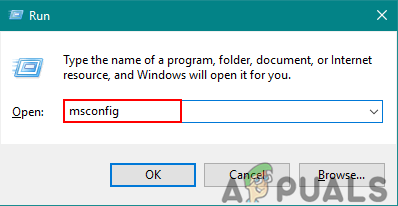
Opening System configuration through Run - Once you manage to get inside the System Configuration menu, click on the Services tab from the top of the menu. Next, start by ensuring that the box associated with ‘Hide all Microsoft services‘ is checked. This will ensure that you don’t mistakenly disable any service that’s essential to your operating system.
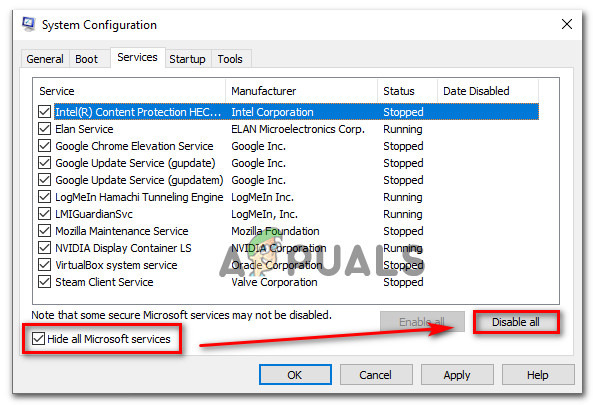
Disabling all non-Microsoft startup items - Once every Microsoft service is excluded from the list, click on the Disable all button to effectively prevent any kind of 3rd party service from being called into action during the next startup sequence.
- After the services have been dealt with, go to the Startup tab and then click on Open Task Manager from the next menu.
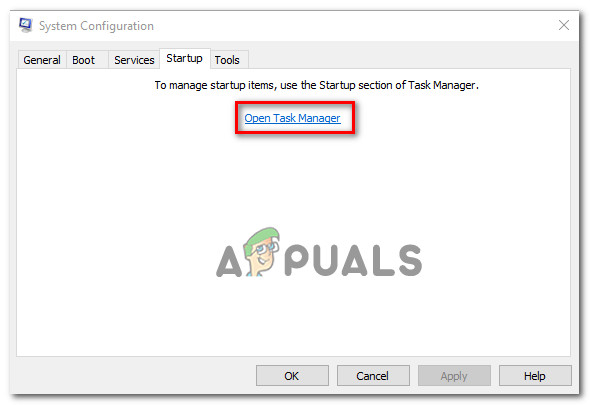
Opening the Startup items window via Task Manager - You will be then transported directly into the Startup tab of Task Manager. Once you get there, systematically select every 3rd party startup service and click the Disable button at the bottom of the screen to exclude them from being started at the next system startup. Do this until you’ve ensured that no startup service is allowed to run at the next system startup.

Disabling Apps from Startup - Once you get to this step, the grounds for the clean boot state are achieved. Now, in order to take advantage of it, simply restart your computer.
- At the next startup, your computer has booted with the essential services and processes ONLY. To test if any 3rd party item was causing the error code, repeat the upgrading process and see if the issue is now resolved.





